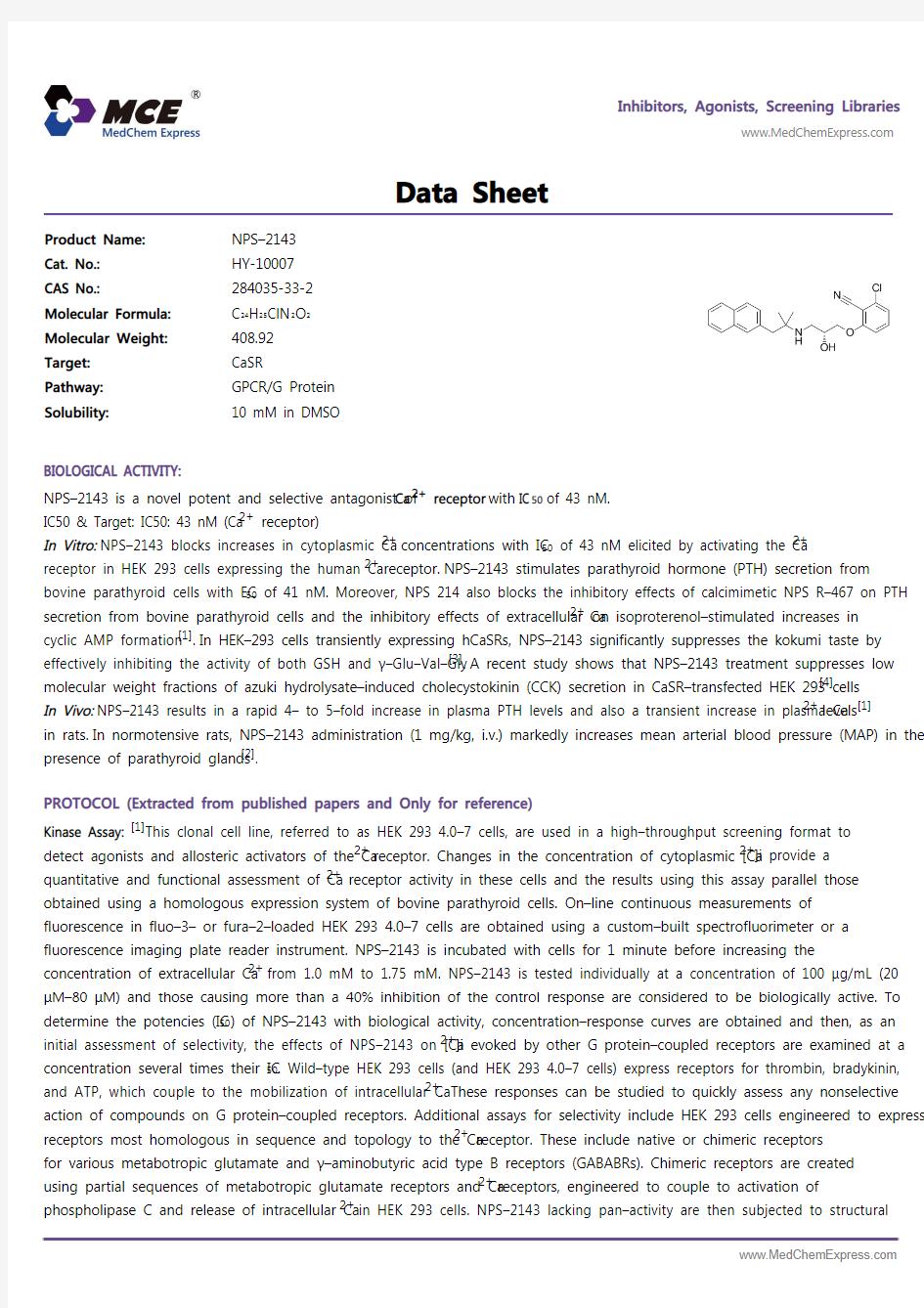NPS-2143_DataSheet_MedChemExpress


Inhibitors, Agonists, Screening Libraries
https://www.360docs.net/doc/098300051.html, Data Sheet
BIOLOGICAL ACTIVITY:
NPS–2143 is a novel potent and selective antagonist of Ca 2+ receptor with IC 50 of 43 nM.
IC50 & Target: IC50: 43 nM (Ca 2+ receptor)
In Vitro: NPS–2143 blocks increases in cytoplasmic Ca 2+ concentrations with IC 50 of 43 nM elicited by activating the Ca 2+
receptor in HEK 293 cells expressing the human Ca 2+ receptor. NPS–2143 stimulates parathyroid hormone (PTH) secretion from bovine parathyroid cells with EC 50 of 41 nM. Moreover, NPS 214 also blocks the inhibitory effects of calcimimetic NPS R–467 on PTH secretion from bovine parathyroid cells and the inhibitory effects of extracellular Ca 2+ on isoproterenol–stimulated increases in cyclic AMP formation [1]. In HEK–293 cells transiently expressing hCaSRs, NPS–2143 significantly suppresses the kokumi taste by effectively inhibiting the activity of both GSH and γ–Glu–Val–Gly [3]. A recent study shows that NPS–2143 treatment suppresses low molecular weight fractions of azuki hydrolysate–induced cholecystokinin (CCK) secretion in CaSR–transfected HEK 293 cells [4].In Vivo: NPS–2143 results in a rapid 4– to 5–fold increase in plasma PTH levels and also a transient increase in plasma Ca 2+ levels [1]in rats. In normotensive rats, NPS–2143 administration (1 mg/kg, i.v.) markedly increases mean arterial blood pressure (MAP) in the presence of parathyroid glands [2].
PROTOCOL (Extracted from published papers and Only for reference)
Kinase Assay:[1]This clonal cell line, referred to as HEK 293 4.0–7 cells, are used in a high–throughput screening format to detect agonists and allosteric activators of the Ca 2+ receptor. Changes in the concentration of cytoplasmic [Ca 2+]i provide a quantitative and functional assessment of Ca 2+ receptor activity in these cells and the results using this assay parallel those obtained using a homologous expression system of bovine parathyroid cells. On–line continuous measurements of
fluorescence in fluo–3– or fura–2–loaded HEK 293 4.0–7 cells are obtained using a custom–built spectrofluorimeter or a
fluorescence imaging plate reader instrument. NPS–2143 is incubated with cells for 1 minute before increasing the
concentration of extracellular Ca 2+ from 1.0 mM to 1.75 mM. NPS–2143 is tested individually at a concentration of 100 μg/mL (20μM–80 μM) and those causing more than a 40% inhibition of the control response are considered to be biologically active. To determine the potencies (IC 50) of NPS–2143 with biological activity, concentration–response curves are obtained and then, as an initial assessment of selectivity, the effects of NPS–2143 on [Ca 2+]i evoked by other G protein–coupled receptors are examined at a concentration several times their IC 50. Wild–type HEK 293 cells (and HEK 293 4.0–7 cells) express receptors for thrombin, bradykinin,and ATP, which couple to the mobilization of intracellular Ca 2+. These responses can be studied to quickly assess any nonselective action of compounds on G protein–coupled receptors. Additional assays for selectivity include HEK 293 cells engineered to express receptors most homologous in sequence and topology to the Ca 2+ receptor. These include native or chimeric receptors
for various metabotropic glutamate and γ–aminobutyric acid type B receptors (GABABRs). Chimeric receptors are created
using partial sequences of metabotropic glutamate receptors and Ca 2+ receptors, engineered to couple to activation of phospholipase C and release of intracellular Ca 2+ in HEK 293 cells. NPS–2143 lacking pan–activity are then subjected to structural
Product Name:
NPS–2143Cat. No.:
HY-10007CAS No.:
284035-33-2Molecular Formula:
C 24H 25ClN 2O 2Molecular Weight:
408.92Target:
CaSR Pathway:
GPCR/G Protein Solubility:
10 mM in DMSO
modifications and their potencies and selectivities monitored using these HEK 293 4.0–7 cell assays in an iterative process.
Animal Administration: NPS–2143 is formulated in 20% aqueous solution of 2–hydroxypropyl–β–cyclodextrin.[1]On the day of study, the rats are infused intravenously (0.1 mL/kg.min) for 120 min with NPS–2143 (0.1 μmol/kg.min) or vehicle, a 20% aqueous solution of 2–hydroxypropyl–β–cyclodextrin. Blood samples (0.5 mL) are collected before and at various times after the start of the infusion for measurements of plasma levels of PTH and Ca2+. To prevent excessive blood volume loss during the course of the experiment, for each blood sample the erythrocyte pellet is resuspended in an equal volume of normal rat plasma and reinjected. Plasma levels of Ca2+ are measured immediately after collection using a model 634 ionized calcium analyzer. PTH levels are measured using the Immutopics rat PTH(1–34) immunoradiometric assay kit.
References:
[1]. Nemeth EF, et al. Calcilytic compounds: potent and selective Ca2+ receptor antagonists that stimulate secretion of parathyroid hormone. J Pharmacol Exp Ther. 2001 Oct;299(1):323–31.
[2]. Rybczynska A, et al. Hypertensive effect of calcilytic NPS 2143 administration in rats. J Endocrinol. 2006 Oct;191(1):189–95.
[3]. Ohsu T, et al. Involvement of the calcium–sensing receptor in human taste perception. J Biol Chem. 2010 Jan 8;285(2):1016–22.
[4]. Nakajima S, et al. Calcium–sensing receptor mediates dietary peptide–induced CCK secretion in enteroendocrine STC–1 cells. Mol Nutr Food Res. 2012 May;56(5):753–60.
Caution: Product has not been fully validated for medical applications. For research use only.
Tel: 609-228-6898 Fax: 609-228-5909 E-mail: tech@https://www.360docs.net/doc/098300051.html,
Address: 1 Deer Park Dr, Suite Q, Monmouth Junction, NJ 08852, USA
